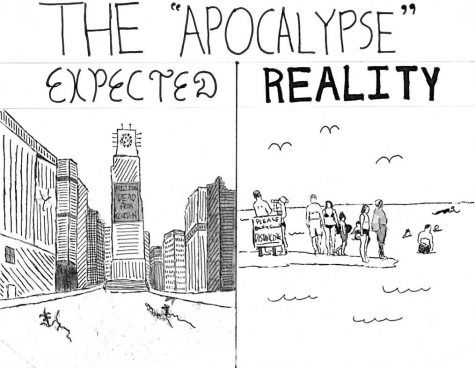Carelessness, not COVID-19, the real cause of catastrophe
May 29, 2020

Six months ago, when someone said ‘apocalypse’, the scene that came to mind was one out of an old end-of-the-world film. The sky a pale grey, mushroom clouds and nuclear winters in the backdrop as those of us still alive struggle to eke out an existence on blighted soil. Now, when someone says ‘apocalypse,’ the scene that comes to mind is that of our crowded grocery stores and empty parks, white masks and empty shelves. You can see it everywhere, in the headlines of our daily newsletters, a buzzword used to herald the end of time as we know it. You can see it in the protestors marching on state capitals, guns brandished high, even as the rest of us watch the upward tick of newly infected, rising higher and higher every day.
The future is unimaginable, therefore it must not exist, right? We have entered the dawning days of the apocalypse, one out of the dusty VHS tapes. Though strangely enough, nothing like what we now are experiencing has been depicted in any of those old movies. Instead of a zombie flu, it’s something else that’s spreading, insidious and air-borne even as we stay inside, tired of our own white walls and backyards. It isn’t even, as you might have thought, the current pandemic that’s the harbinger of our doom. It’s growing carelessness.
The truth is, without people disregarding the nationwide plea to stay at home for non-essential activities, without those of us walking around without masks and proper sanitation procedures, there wouldn’t be this big of a problem. If the US had been vigilant to the growing threat in the beginning, if we had cared more about our own personal safety, the compounded problems that we currently face would not be here. Even now, if people could only realize that flattened curves are a sign of the effectiveness of stay-at-home orders instead of that of an overreaction, we would be in a better place with our public health. It’s the apocalypse, but not the kind we think it is.
For the majority of us, there is food and electricity and days suddenly empty, hours stretching out that not even the sudden flood of online Zoom classes can fill. It isn’t a hard existence. For those of us who have the means to survive it, one might even call it pleasant, but somehow, it’s been deemed unbearable. Given the platforms to voice our own discomfort, the need to gather and socialize has echoed, until it seems like everyone is tired of staying home, even as the carelessness that got us to this state in the first place magnifies.
It’s unimaginable that so many normally level-headed people would be outside while the threat of viral infection still lingers in our air, while the risk of contagion is still so high, yet here we are. This last Memorial weekend, state parks and restaurants reported higher-than-normal numbers of visitors, families and couples going out to catch a breath of fresh air and possibly COVID-19. Of those going outside, there’s been a growing number going without masks, eschewing the barest of safety precautions because the feeling of a damp face mask is the worst in the world, one that not even being hooked up to a ventilator can beat.
From the beginning to the end, this current predicament is one of our own making. It’s human carelessness that lets COVID-19 spread, and it’s human care that will be the key to beating it. No matter how much time and effort we place into trying to beat the pandemic, it cannot be done unless all of us start doing our part


